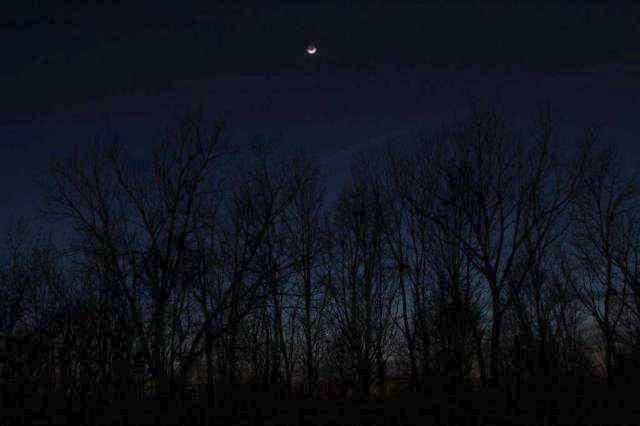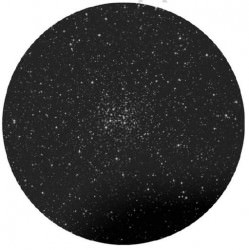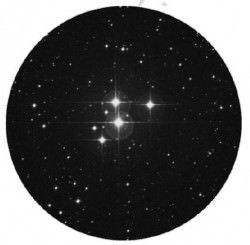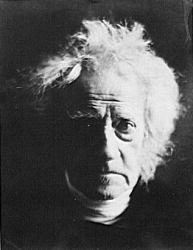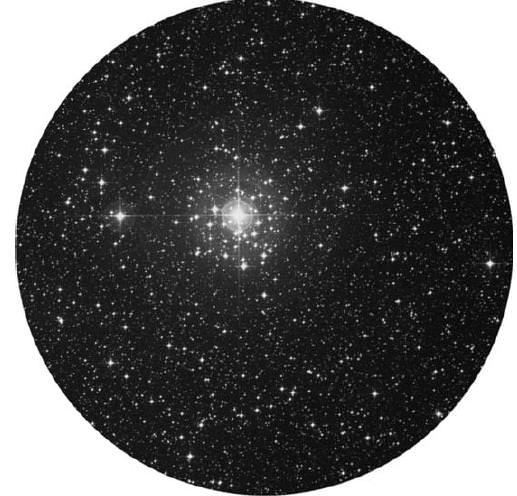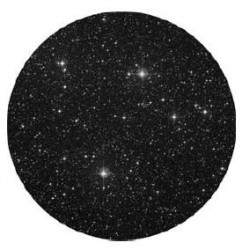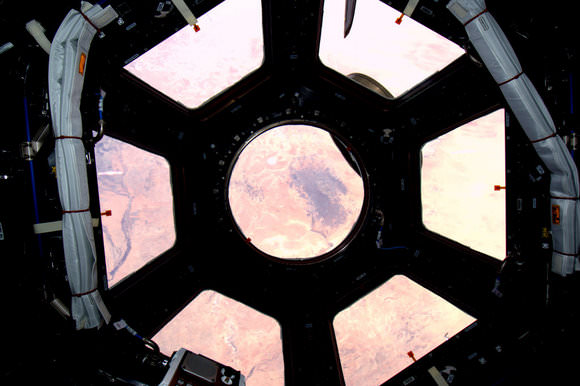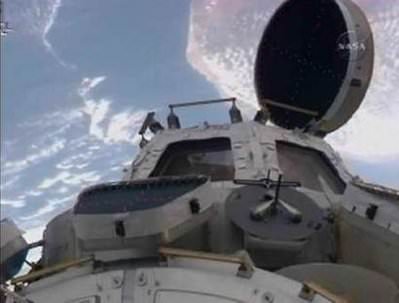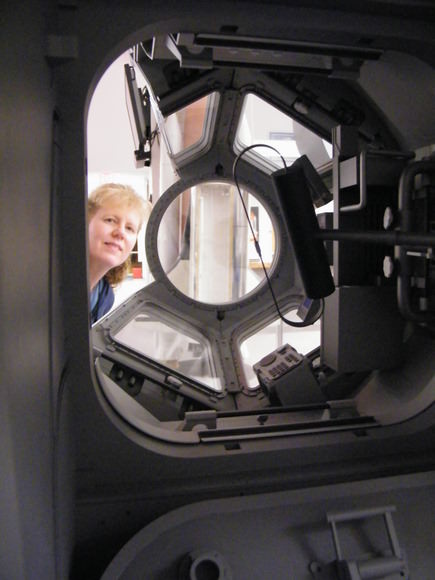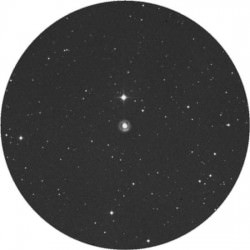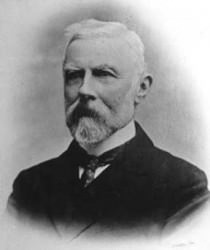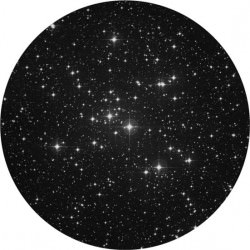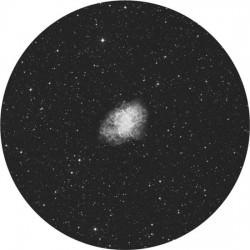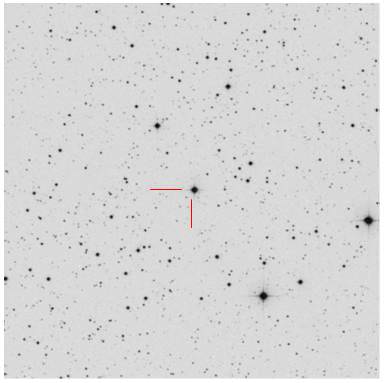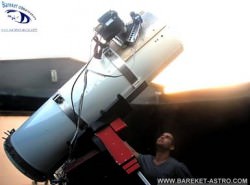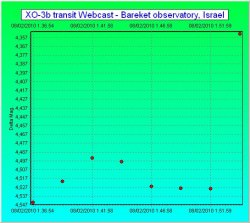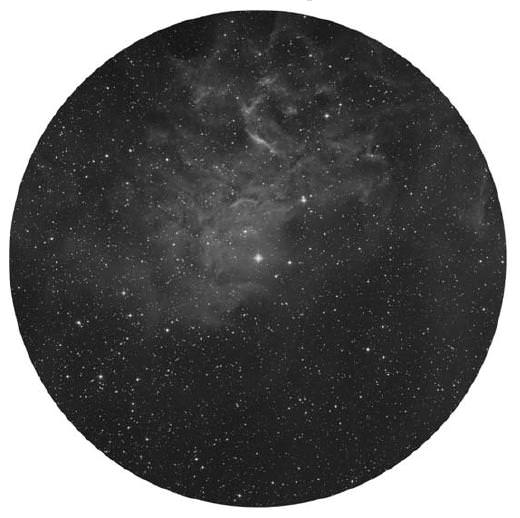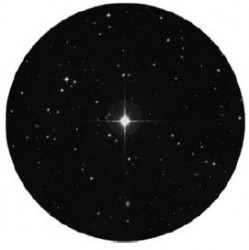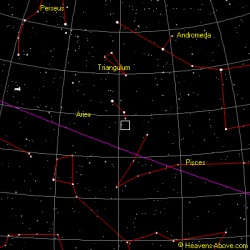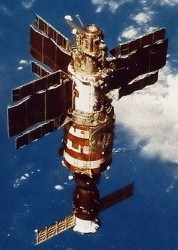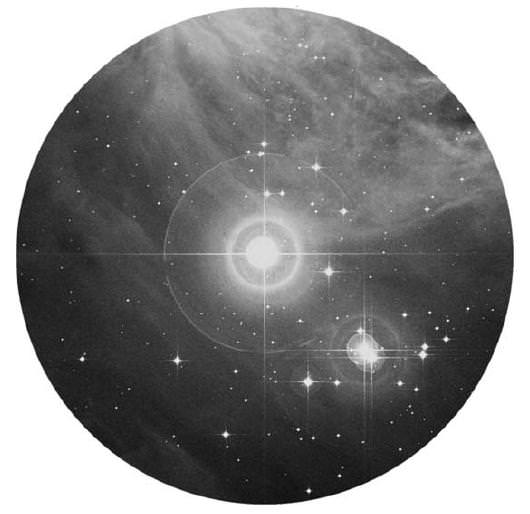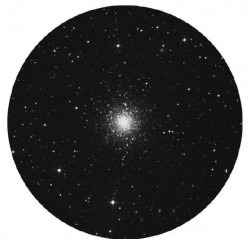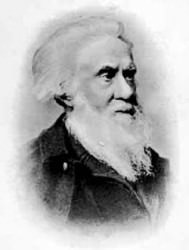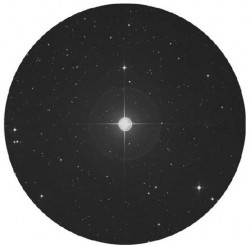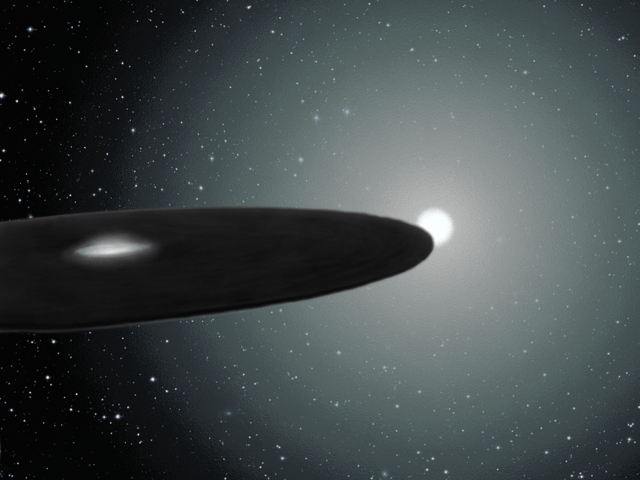Greetings, fellow SkyWatchers! As one hemisphere warms, another cools… and so our passion for astronomy can sometimes wax and wane. Why not rekindle your viewing spirit by enjoying some lunar targets this weekend? If you don’t think identifying lunar features with a small pair of binoculars is exciting – then think on this: Using the most simple form of optics, you are viewing details on a distant world that’s a quarter of a million miles away! So what are you waiting for? Get out your binoculars and get ready to enjoy… and I’ll see you in the backyard.
 March 19, 2010 – We begin our binocular and small telescope explorations tonight by looking near the center of the lunar terminator to identify and take a closer look at Mare Fecunditatis. Its expanse covers 1463 kilometers in diameter. The combined area of this mare is equal in size to the Great Sandy Desert in Australia—and almost as vacant in interior features. It is home to glasses, pyroxenes, feldspars, oxides, olivines, troilite and metals in its lunar soil, which is called regolith. Studies show the basaltic flow inside of the Fecunditatis basin perhaps occurred all at once, making its chemical composition different from other maria. The lower titanium content means it is between 3.1 and 3.6 billion years old. Stretching out across an area about equal in size to the state of California, the Sea of Fertility’s western edge is home to features we share terrestrially – grabens. These down-dropped areas of landscape between parallel fault lines occur where the crust is stretched to the breaking point. On Earth, these happen along tectonic plates, but on the Moon they are found around basins. The forces created by lava flow increase the weight inside the basin, causing a tension along the border which eventually fault and cause these areas. Look closely along the western shore of Fecunditatis where you will see many such graben features. They are also bordered by parallel fault lines and are quite similar to such terrestrial features as Death Valley in the western United States.
March 19, 2010 – We begin our binocular and small telescope explorations tonight by looking near the center of the lunar terminator to identify and take a closer look at Mare Fecunditatis. Its expanse covers 1463 kilometers in diameter. The combined area of this mare is equal in size to the Great Sandy Desert in Australia—and almost as vacant in interior features. It is home to glasses, pyroxenes, feldspars, oxides, olivines, troilite and metals in its lunar soil, which is called regolith. Studies show the basaltic flow inside of the Fecunditatis basin perhaps occurred all at once, making its chemical composition different from other maria. The lower titanium content means it is between 3.1 and 3.6 billion years old. Stretching out across an area about equal in size to the state of California, the Sea of Fertility’s western edge is home to features we share terrestrially – grabens. These down-dropped areas of landscape between parallel fault lines occur where the crust is stretched to the breaking point. On Earth, these happen along tectonic plates, but on the Moon they are found around basins. The forces created by lava flow increase the weight inside the basin, causing a tension along the border which eventually fault and cause these areas. Look closely along the western shore of Fecunditatis where you will see many such graben features. They are also bordered by parallel fault lines and are quite similar to such terrestrial features as Death Valley in the western United States.
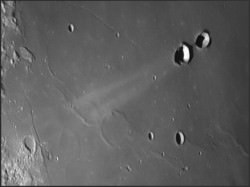 Now aim towards the earthen shore of Mare Fecunditatus and identify the flat, bright oval of a previous study, Langrenus. This is an opportunity to challenge yourself by identifying two small craters just slightly northwest of the mare’s central point – Messier and Messier A – named for the famous French comet hunter – Charles Messier. Scan along the terminator over Mare Fecunditatis about 1/3 its width from west to east for a pair of emerging bright rings. These twin craters will be difficult in binoculars, but not hard for even a small telescope and intermediate power. The easternmost crater is somewhat oval in shape with dimensions of 9 by 11 kilometers. At high power, Messier A to the west appears to have overlapped a smaller crater during its formation and it is slightly larger at 11 by 13 kilometers. For a challenging telescopic note, you’ll find another point of interest to the northwest. Rima Messier is a long surface crack which runs diagonally across Mare Fecunditatis’ northwestern flank and reaches a length of 100 kilometers. Keep the Messiers in mind, for in a few days you will see a pair of “rays” extending out from them.
Now aim towards the earthen shore of Mare Fecunditatus and identify the flat, bright oval of a previous study, Langrenus. This is an opportunity to challenge yourself by identifying two small craters just slightly northwest of the mare’s central point – Messier and Messier A – named for the famous French comet hunter – Charles Messier. Scan along the terminator over Mare Fecunditatis about 1/3 its width from west to east for a pair of emerging bright rings. These twin craters will be difficult in binoculars, but not hard for even a small telescope and intermediate power. The easternmost crater is somewhat oval in shape with dimensions of 9 by 11 kilometers. At high power, Messier A to the west appears to have overlapped a smaller crater during its formation and it is slightly larger at 11 by 13 kilometers. For a challenging telescopic note, you’ll find another point of interest to the northwest. Rima Messier is a long surface crack which runs diagonally across Mare Fecunditatis’ northwestern flank and reaches a length of 100 kilometers. Keep the Messiers in mind, for in a few days you will see a pair of “rays” extending out from them.
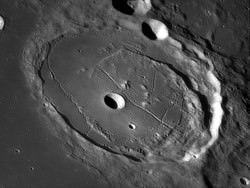 March 20, 2010 – On the lunar surface tonight, let’s begin with a look at Mare Serenitatus – the “Serene Sea”. On its northeast shore, binoculars will have no trouble spotting the shallow ring of crater Posidonius. Almost flat from eons of lava flows, this crater shows numerous variations in texture along its floor in small telescopes. This huge, old, mountain-walled plain is considered a class V crater and could be as much as 3 billion years old. Spanning 84 by 98 kilometers, you can plainly see Posidonius is shallow – dropping only 2590 meters below the surface. Tonight it will resemble a bright, elliptical pancake on the surface to smaller optics with its ring structure remaining conspicuous to binoculars throughout all lunar phases. However, a telescope is needed to appreciate the many fine features found on Posidonius’ floor. Power up to observe the stepped, stadium-like wall structure and numerous resolvable mountain peaks joining its small, central interior crater. It has its own interior rimae that is especially prominent to the east and a smashing view of trio Posidonius O, I and B on the north crater rim. Adding crater Chacornac to the southeast makes things even more interesting! Did you spot the small punctuation of Daniell to the north?
March 20, 2010 – On the lunar surface tonight, let’s begin with a look at Mare Serenitatus – the “Serene Sea”. On its northeast shore, binoculars will have no trouble spotting the shallow ring of crater Posidonius. Almost flat from eons of lava flows, this crater shows numerous variations in texture along its floor in small telescopes. This huge, old, mountain-walled plain is considered a class V crater and could be as much as 3 billion years old. Spanning 84 by 98 kilometers, you can plainly see Posidonius is shallow – dropping only 2590 meters below the surface. Tonight it will resemble a bright, elliptical pancake on the surface to smaller optics with its ring structure remaining conspicuous to binoculars throughout all lunar phases. However, a telescope is needed to appreciate the many fine features found on Posidonius’ floor. Power up to observe the stepped, stadium-like wall structure and numerous resolvable mountain peaks joining its small, central interior crater. It has its own interior rimae that is especially prominent to the east and a smashing view of trio Posidonius O, I and B on the north crater rim. Adding crater Chacornac to the southeast makes things even more interesting! Did you spot the small punctuation of Daniell to the north?
 Now, look a bit south of and east of Posidonius and almost parallel to the terminator for a curious feature known as the Serpentine Ridge, or more properly as Dorsa Smirnov and the accompanying Dorsa Lister. Can you detect the very tiny crater Very in its center? This thin, white line wanders across the western portion of Mare Serenitatus for a distance of about 134 kilometers. In some places it rises as high as 305 meters above the smooth sands. This lunar “wrinkle” is an amazing 10 kilometers wide! Power up in a telescope. The northern portion of the Serpentine Ridge is Dorsa Smirnov until it branches west and becomes Dorsa Lister. If the shadow play is good at your time, you might be lucky enough to resolve Dorsum Nicol, which connects the two. Only about 51 kilometers long, Dorsum Nichol will appear almost as a circular, crater-like feature – but it isn’t. As part of the Mare Serenitatis / Mare Tranquilitatis border, it’s not much more than a just an area where the two distinct lava flows cooled and contracted, causing the surface to heave up, but you’ll also find it’s connected to the Rima Plinius as well.
Now, look a bit south of and east of Posidonius and almost parallel to the terminator for a curious feature known as the Serpentine Ridge, or more properly as Dorsa Smirnov and the accompanying Dorsa Lister. Can you detect the very tiny crater Very in its center? This thin, white line wanders across the western portion of Mare Serenitatus for a distance of about 134 kilometers. In some places it rises as high as 305 meters above the smooth sands. This lunar “wrinkle” is an amazing 10 kilometers wide! Power up in a telescope. The northern portion of the Serpentine Ridge is Dorsa Smirnov until it branches west and becomes Dorsa Lister. If the shadow play is good at your time, you might be lucky enough to resolve Dorsum Nicol, which connects the two. Only about 51 kilometers long, Dorsum Nichol will appear almost as a circular, crater-like feature – but it isn’t. As part of the Mare Serenitatis / Mare Tranquilitatis border, it’s not much more than a just an area where the two distinct lava flows cooled and contracted, causing the surface to heave up, but you’ll also find it’s connected to the Rima Plinius as well.
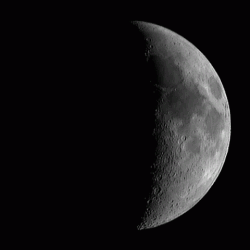 March 21, 2010 – Tonight on the lunar surface, all of Mare Serenitatis and Mare Tranquillitatis will be revealed, and so it is fitting we should take an even closer look at both the “Serene” and “Tranquil” seas. Formed some 38 million years ago, these two areas of the Moon have been home to most of mankind’s lunar exploration. Somewhere scattered on the basalt landscape on the western edge of Tranquillitatis, a few remains of the Ranger 6 mission lie tossed about, perhaps forming a small impact crater of their own. Its eyes were open, but blinded by a malfunction…forever seeing nothing. To the southwest edge lie the remnants of the successful Ranger 8 mission which sent back 7137 glorious images during the last 23 minutes of its life. Nearby, the intact Surveyor 5 withstood all odds and made space history by managing to perform an alpha particle spectrogram of the soil while withstanding temperatures considerably greater than the boiling point. Not only this, but it also took over 18,000 pictures!
March 21, 2010 – Tonight on the lunar surface, all of Mare Serenitatis and Mare Tranquillitatis will be revealed, and so it is fitting we should take an even closer look at both the “Serene” and “Tranquil” seas. Formed some 38 million years ago, these two areas of the Moon have been home to most of mankind’s lunar exploration. Somewhere scattered on the basalt landscape on the western edge of Tranquillitatis, a few remains of the Ranger 6 mission lie tossed about, perhaps forming a small impact crater of their own. Its eyes were open, but blinded by a malfunction…forever seeing nothing. To the southwest edge lie the remnants of the successful Ranger 8 mission which sent back 7137 glorious images during the last 23 minutes of its life. Nearby, the intact Surveyor 5 withstood all odds and made space history by managing to perform an alpha particle spectrogram of the soil while withstanding temperatures considerably greater than the boiling point. Not only this, but it also took over 18,000 pictures!
 Now let’s go to the southwest edge of Tranquillitatis and visit with the Apollo 11 landing area. Although we can never see the “Eagle” telescopically, we can find where it landed. For telescopes and binoculars the landing area will be found near the terminator along the southern edge of Mare Tranquillitatis. No scope? No problem. Find the dark round area on the lunar northeastern limb – Mare Crisium. Then locate the dark area below that – Mare Fecundatatis. Now look mid-way along the terminator for the dark area that is Mare Tranquillitatis. The bright point west where it joins Mare Nectaris further south is the target for the first men on the Moon. We were there! Telescopically, start tracing the western wall of Tranquillitatis and looking for the small circles of craters Sabine and Ritter which are easily revealed tonight.
Now let’s go to the southwest edge of Tranquillitatis and visit with the Apollo 11 landing area. Although we can never see the “Eagle” telescopically, we can find where it landed. For telescopes and binoculars the landing area will be found near the terminator along the southern edge of Mare Tranquillitatis. No scope? No problem. Find the dark round area on the lunar northeastern limb – Mare Crisium. Then locate the dark area below that – Mare Fecundatatis. Now look mid-way along the terminator for the dark area that is Mare Tranquillitatis. The bright point west where it joins Mare Nectaris further south is the target for the first men on the Moon. We were there! Telescopically, start tracing the western wall of Tranquillitatis and looking for the small circles of craters Sabine and Ritter which are easily revealed tonight.
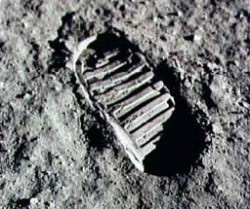 Once located, switch to your highest magnification. Look in the smooth sands to the east to see a parallel line of three tiny craters. From west to east, these are Aldrin, Collins, and Armstrong – the only craters to be named for the living. It is here where Apollo 11 touched down, forever changing our perception of space exploration.
Once located, switch to your highest magnification. Look in the smooth sands to the east to see a parallel line of three tiny craters. From west to east, these are Aldrin, Collins, and Armstrong – the only craters to be named for the living. It is here where Apollo 11 touched down, forever changing our perception of space exploration.
“That’s one small step for [a] man, one giant leap for mankind.”
Until next week? Ask for the Moon… But keep on reaching for the stars!
This week’s awesome images are (in order of appearance): Crescent Moon and Venus In the Trees courtesy of Mike Romine, Mare Fecunditatus courtesy of Virtual Moon Atlas, Craters Messier and Posidonius courtesy of Damien Peach, “Serpentine Ridge” and Six Day Moon courtesy of Peter Lloyd, Lunar History Area courtesy of Virtual Moon Atlas and “Footstep” courtesy of NASA. We thank you so much!

